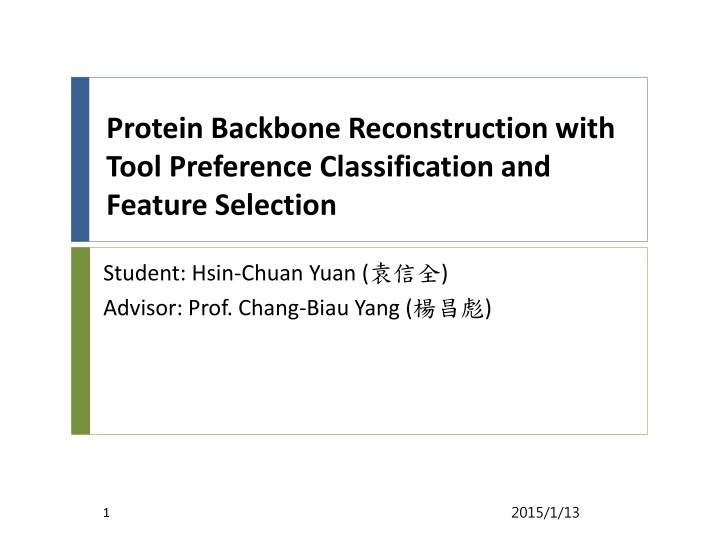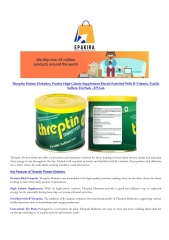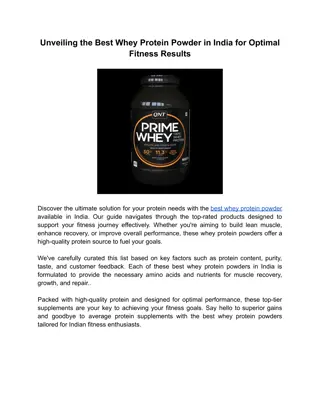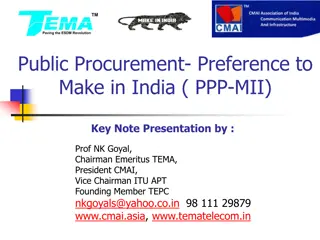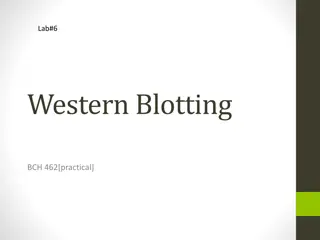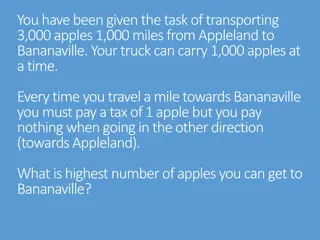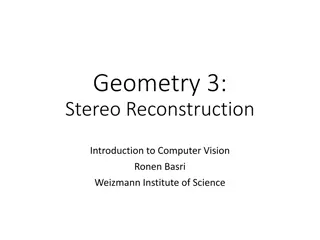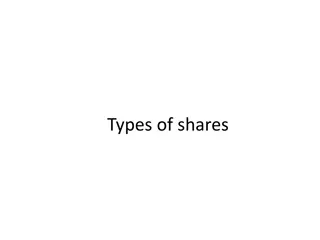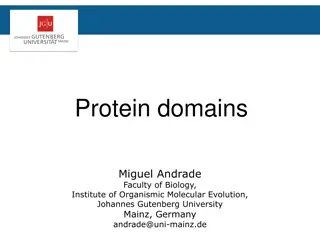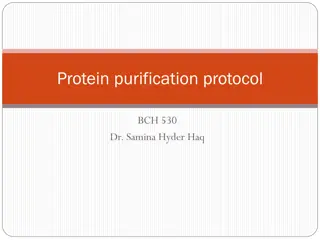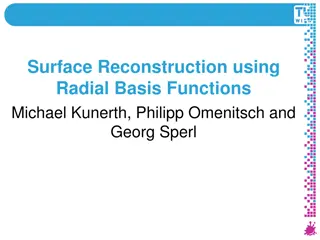Protein Backbone Reconstruction: Tool Preference and Feature Selection
This research focuses on protein backbone reconstruction, exploring tools, classification, and feature selection methods. It discusses the Protein Databank (PDB), peptide bonds, CASP experiments, RMSD calculations, and SVM modeling, shedding light on vital aspects of protein structure analysis. Previous works by Chen are highlighted for their approach in determining tool usage on protein atoms.
Download Presentation

Please find below an Image/Link to download the presentation.
The content on the website is provided AS IS for your information and personal use only. It may not be sold, licensed, or shared on other websites without obtaining consent from the author.If you encounter any issues during the download, it is possible that the publisher has removed the file from their server.
You are allowed to download the files provided on this website for personal or commercial use, subject to the condition that they are used lawfully. All files are the property of their respective owners.
The content on the website is provided AS IS for your information and personal use only. It may not be sold, licensed, or shared on other websites without obtaining consent from the author.
E N D
Presentation Transcript
Protein Backbone Reconstruction with Tool Preference Classification and Feature Selection Student: Hsin-Chuan Yuan ( ) Advisor: Prof. Chang-Biau Yang ( ) 2015/1/13 1
Introduction (1/4) Protein Backbone Reconstruction Problem (PBRP) Input: A protein sequence and its all C coordinates Output: The coordinates of N, C and O atoms on the backbone Previous works: SABBAC BBQ (Backbone Building from Quadrilaterals) Wang s method Chang s method PD2 Chen s method Wu s method 2 2015/1/13
Three-letter Abbreviation One-letter Abbreviation Amino Acid Introduction (2/4) 1 Alanine Ala A 2 Arginine Arg R A protein is a consecutive chain of amino acids. 3 Asparagine Asn N 4 Aspartic Acid Asp D 5 Cysteine Cys C 6 Glutamic Acid Glu E 7 Glutamine Gln Q 8 Glycine Gly G 9 Histidine His H 10 Isoleucine Ile I 11 Leucine Leu L 12 Lysine Lys K 13 Methionine Met M 14 Phenylalanine CH3 Phe F 15 Proline Pro P 16 Serine Ser S +H3N COO- C 17 Threonine Thr T 18 Tryptophan Trp W H 19 Tyrosine Tyr Y The fundamental structure of Alanine. 20 Valine Val V 2015/1/13 3
Introduction (3/4) Peptide bond and backbone 2015/1/13 4
Introduction (4/4) Critical assessment of protein structure prediction (CASP) is a world-wide experiments and contest for protein structure prediction. Protein data bank (PDB) archive contains information about the 3D structures of proteins and nucleic acids. The numbers of the protein structures deposited to PDB per year. 2015/1/13 5
Root Mean Square Deviation (RMSD) The RMSD is a measure of similarity between a predicted structure and a real one. RMSD formula: ? 1 ? ?=1 ?2 ? ?? ???? = ?? 2015/1/13 6
Support Vector Machine (SVM) SVM is a supervised learning model which can be applied to classification or regression. 2015/1/13 7
Previous Work (1/2) Chen determines the tool to be used on N, C and O atoms of each protein. The feature vector are derived from a coding rule which applied on the 9 common properties of amino acids of each protein. 2015/1/13 8
Previous Work (2/2) Wu modified the Chen s method. The feature vector were derived from 13 common properties of amino acids of each protein and the properties of the adjacent amino acids. 2015/1/13 9
Model Example Models 20*3 models. P1 E-C-D-E-C-D-D-C A:0.3, C:0.4, D:0.5, E:0.6 Window size = 3 label v1 v2 V3 0 0.4 0.5 0.6 1 0.4 0.5 0.5 0 0.5 0.5 0.4 10 2015/1/13
Previous Work (2/2) Wu extracts the feature sets by 5 different combinations which are selected arbitrarily. 2015/1/13 11
Our Method (1/5) Our Method is based on Wu s method which determines the tool to be used on prediction. We aim to select significant features to obtain higher accuracy and increase the efficiency. We further use 136 properties of amino acids (from AAindex ver.9.1) as the training features. In order to balance the significance of each property of amino acids, we modified Wu s method on the feature vectors by normalizing the properties. 2015/1/13 12
AAindex example Property ANDN920101 4.35 4.17 4.38 4.36 4.75 4.52 4.76 4.66 4.65 4.44 4.37 4.5 4.29 4.35 3.97 4.7 4.63 4.6 3.95 3. ARGP820101 0.61 1.53 0.6 1.15 0.06 1.18 0.46 2.02 1.07 1.95 0 0.05 0.47 0.05 0.07 2.65 0.61 1.88 2.22 1.3 ARGP820102 1.18 3.23 0.2 0.06 0.23 2.67 0.05 1.96 1.89 0.76 0.72 0.97 0.11 0.84 0.49 0.77 0.31 0.39 1.45 A L R K N M D F C P Q S E T G W H Y I V 2015/1/13 13
Our Method (2/5) A grid-search technique was used to determine the best parameters, cost and . The two parameters were limit in 2-10to 2-5and 2-3to 22, respectively. 2015/1/13 14
Our Method (3/5) Singular value decomposition (SVD) is used in our method for dimensionality reduction. 2015/1/13 15
Our Method (4/5) Fisher score measure each feature independently according to their scores under the Fisher criterion. ?(?) =|?1 ?2| ?1+ ?2 2015/1/13 16
Experimental Results The Fisher score of the 136 features for CASP7, CASP8 and CASP9. 2015/1/13 17
Our Method (5/5) Distance correlation is another method used to measure the statistical dependence between two vectors. Not necessarily equal dimension. 2015/1/13 18
Experimental Results The distance correlation of the 136 features in CASP7, CASP8 and CASP9. 2015/1/13 19
Experimental Results We adopt Wu s method with all of the 136 properties for predicting. 2015/1/13 20
Experimental Results The correlation coefficient and Spearman s rank correlation coefficient between two Fisher scores in CASPs. 2015/1/13 21
Experimental Results The correlation coefficient between two results of distance correlation in CASPs. 2015/1/13 22
Single feature testing feature feature RMSD features Top 7 features case 2015/1/13 23
Single feature testing feature feature RMSD features Top 7 features 0.5 0.45 0.4 0.35 0.3 0.25 0.2 0.15 0.1 0.05 0 7-7 7-8 7-9 8-7 8-8 8-9 9-7 9-8 9-9 TOP2 TOP3 TOP4 TOP5 TOP6 TOP7 ALL 2015/1/13 24
Leave-one-protein-out CASP7 CASP7 CASP8 CASP8 CASP9 CASP9 CASP10 CASP10 2015/1/13 25
Leave-one-out 7-7 8-8 9-9 10-10 No Thresh 0.3584 0.4460 0.4254 0.3578 Threshold Tuning Thresh=0.05 0.3546 0.4442 0.4295 0.3573 Thresh=0.10 0.3447 0.4184 0.4226 0.3464 Top 7 features BBQ PD2 Threshold = 0.05~0.20 Thresh=0.20 0.3345 0.4235 0.4154 0.3437 PD2 0.3335 0.4042 0.4096 0.3386 Atom O Thresh=0.15 Atom N,C Thresh=0.10 0.3420 0.4032 0.4089 0.3368 Threshold Threshold N, C 0.1 0.15 0.46 0.44 0.42 PD2 PD2 0.4 0.38 0.36 0.34 PD2 PD2 0.32 No threshold Thresh=0.05 Thresh=0.10 Thresh=0.20 7 7 8 8 9 9 10 10 2015/1/13 26
Single feature testing features Top 10 features top 7 features SVMs 60 SVM top 10 features A C D E F G H I K L M O P Q R S T V W Y CASP7-CASP7 Atom O Thresh=0.15 Atom N,C Thresh=0.10 0.34168 0.40119 0.39979 0.34693 PD2 0.3335 0.4042 0.4096 0.3386
Probability estimation SVM b 1 PD2 (RMSD BBQ ) PD2 Threshold 0 1 Threshold 7-7 8-8 9-9 10-10 Non 0.34168 0.40119 0.39979 0.34693 0.55 0.33544 0.40353 0.39997 0.34495 0.60 0.33391 0.40478 0.40956 0.33929 0.65 0.33396 0.40168 0.40494 0.34238 PD2 0.3335 0.4042 0.4096 0.3386 2015/1/13 28
Window size Parameters NC=0.1, O=0.15, -b 0 7-7 8-8 9-9 10-10 Window size = 25 0.34168 0.40119 0.39979 0.34693 Window size = 13 0.33871 0.40215 0.39847 0.34367 Window size = 7 0.34084 0.40366 0.39706 0.34453 PD2 0.3335 0.4042 0.4096 0.3386 2015/1/13 30
The Behavior-Knowledge Space Method BKS C1 C2 C3 0 0 0 250 11 2 7 0 0 1 13 17 0 0 0 1 0 118 2 0 0 0 1 1 32 12 2 3 1 0 0 15 16 5 1 1 0 1 3 127 1 0 1 1 0 16 8 1 3 1 1 1 8 270 4 2 2015/1/13 31
The Behavior-Knowledge Space Method and Experimental Results 7-7 8-8 9-9 10-10 0.3465 0.34625 0.35249 0.34745 0.3546 0.34819 0.34387 0.43562 0.44081 0.428 0.4288 0.42699 0.42697 0.42528 0.42217 0.41811 0.40849 0.40551 0.42847 0.41235 0.40828 PSSM, Top10, WU (features set) 0.3522 0.34544 PSSM, Top10, Btm10 (features set) SVM KERNEL=0(linear) SVM KERNEL=1(polynomial) SVM KERNEL=3(sigmoid) 0.3572 0.35993 SVM KERNEL=0, 1, 2(radial basis) WEKA, SVM WEKA Method 1 Method 2 CASP7 rules.PART rules.ZeroR CASP8 meta.AttributeSelectedClassifier meta.RandomCommittee CASP9 meta.AttributeSelectedClassifier meta.FilteredClassifier CASP10 meta.RandomCommittee trees.RandomForest 2015/1/13 32
